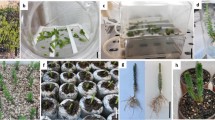Abstract
An efficient, simple micropropagation method was developed for Alocasia amazonica using corms in semisolid and liquid cultures. Explants were cultured onto Murashige and Skoog (MS) medium (Murashige and Skoog, Physiol. Plant. 15:473–497, 1962) supplemented with different cytokinins (Benzyladenine [BA, 2.22–13.32 μM], kinetin [2.32–13.95 μM], Thidiazuron [TDZ, 0.45–4.54 μM]) and cytokinin in combination with auxins [naphthalene acetic acid (NAA, 0.54–5.37 μM)/indole acetic acid (IAA, 0.57–5.71 μM)/indole butyric acid (IBA, 0.49–4.9 μM)]. All supplementary-induced shoot proliferation and the optimal results was on the medium supplemented with 2.27 μM TDZ, which induced 5.1 shoots per explant. Among the different concentrations of sucrose (0–120 g l−1) tested for shoot proliferation, 30 g l−1 was found suitable for corm cultures of Alocasia amazonica. The optimal shoot proliferation and biomass values were with the plantlets grown at 30 μmol m−2 s−1 photosynthetic photon flux (PPF) and 25°C. Liquid cultures found suitable for shoot proliferation and biomass accumulation was compared to semisolid cultures. Comparative studies of bioreactor systems [continuous immersion (with or without net) and temporary immersion in liquid media using ebb and flood] revealed that shoot multiplication and growth were greatest with the raft bioreactor system. Plantlets (cormlets) from the bioreactor were hydroponically cultured for 30 days, and 100% of plants were acclimatized successfully. The simple efficient method of production of plantlets (cormlets) is useful for large-scale multiplication of this important ornamental plant.



Similar content being viewed by others
References
Adelberg, J. Plant Growth and sugar utilization in an agitated, thin-film liquid system for micropropagation. In Vitro Cell. Dev. Biol. Plant 40: 245–250; 2004.
Adelberg, J.; Toler, J. Comparison of agar and thin-film liquid system for micropropagation of ornamental Alocasia and Colocasia. HortScience 39: 1088–1092; 2004.
D’Agostino, I.B.; Kieber, J.J. Molecular mechanisms of cytokinin action. Curr. Opin. Plant Biol. 2: 359–364; 1999.
Dantu, P.K.; Bhojwani, S.S. In vitro propagation and corm formation in Gladiolus. Gartenbauwissenschaft 52: 90–93; 1987.
Dewir, Y.H.; Chakrabarthy, D.; Hahn, E.J.; Paek, K.Y. A simple method for mass propagation of Spathiphyllum cannifolium using an airlift bioreactor. In Vitro Cell. Dev. Biol. Plant 42:291–297; 2006.
Eklof, S.; Astot, C.; Blackwell, J.; Moritz, T.; Olsson, O.; Sandberg, G. Auxin–cytokinin interactions in wild-type and transgenic tobacco. Plant Cell Physiol. 38: 225–235; 1997.
Escalona, M.; Samson, G.; Borroto, C.; Disjardins, Y. Physiology of effects of temporary immersion bioreactors on micropropagated pineapple plantlets. In Vitro Cell. Dev. Biol. Plant 39: 651–656; 2003.
Hartmann, H.; Kester, D.; Davies, F.; Geneve, R. Plant propagation: Principles and practices. 6th ed. Prentice-Hall, Upper Saddle River, N.J. 1997.
Ilan, A.; Ziv, M.; Halevy, A.H. Propagation and corm development of Brodiaea in liquid cultures. Sci. Hortic. 63: 101–112; 1995.
Kim, E.K.; Hahn, E.J.; Murthy, H.N.; Paek, K.Y. Enhanced shoot and bulblet proliferation of garlic (Allium sativum L.) in bioreactor system. J. Hort. Sci. Biotechnol. 79: 818–822; 2004.
Lian, M.L.; Chakrabarty, D.; Paek, K.Y. Growth of Lilium oriental hybrid ‘Casablanca’ bulblet using bioreactor culture. Sci. Hortic. 97: 41–48, 2003.
Lichtenthaler, H.K. Chlorophyll and carotenoids: pigments of photosynthetic biomembranes. Methods Enzymol. 148: 350–382; 1987.
Mares, D.J.; Sowokinos, J.R.; Hawker, J.S. Carbohydrate metabolism in developing potato tubers. In: Li, P.H. ed. Potato Physiology. Orlando; Academic Press; 1985: 279–327.
Murashige, T.; Skoog, F. A revised medium for rapid growth a bioassays with tobacco tissue cultures. Physiol. Plant. 15:473–497; 1962.
Murch, S.J.; Choffe, K.L.; Victor, J.M.R.; Slimmon, T.Y.; Krishnaraj, S.; Saxena, P.K. Thidiazuron-induced plant regeneration from hypocotyl cultures of St. John’s wort (Hypricum perforatum cv. ‘Anthos’). Plant Cell Rep. 19: 576–581; 2000.
Paek, K.Y.; Hahn, E.J.; Son, S.H. Application of bioreactors for large scale micropropagation systems of plants. In Vitro Cell. Dev. Biol. Plant. 37: 149–157; 2001.
Park, S.Y.; Murthy, H.N.; Paek, K.Y. Mass multiplication of protocorm-like bodies (PLBs) using bioreactor system and subsequent plant regeneration in Phalaenopsis. Plant Cell Tiss. Org. Cult. 63: 67–72; 2000.
Sato, S.S.; Mori, H. Control in outgrowth and dormancy in axillary buds. Plant Physiol. 127: 1405–1413; 2001.
Visser, C.; Quraeshi, J.A.; Gill, R.; Saxena, P.K. Morphoregulatory role of thidiazuron, substitution of auxin and cytokinin requirement for the induction of somatic embryogenesis in geranium hypocotyl cultures. Plant Physiol. 99: 1704–1707; 1992.
Ziv, M. Enhanced shoot and cormlet proliferation in liquid cultured gladiolus buds by growth retardants. Plant Cell Tiss. Org. Cult. 17: 101–110; 1989.
Ziv, M.; Ariel, T. Bud proliferation and plant regeneration in liquid cultured philodendron treated with ancymidol and paclobutrazol. J. Plant Growth Regul. 10: 53–57; 1991.
Ziv, M.; Hadar, A. Morphogenic pattern of Nephrolepsis exaltata bostoniensis in agar-gelled or liquid culture. Implication for mass propagation. Israel. J. Bot. 40: 7–16; 1991.
Acknowledgement
This work is financially supported by the Ministry of Education and Human Resources Development (MOE), the Ministry of Commerce, Industry and Energy (MOCIE), and the Ministry of Labor (MOLAB) through the fostering project entitled Laboratory of Excellence. One of the authors (H.N. Murthy) is thankful to Korean Federation of Science and Technology Societies (KOFST) for the award of Brain Pool Fellowship.
Author information
Authors and Affiliations
Corresponding author
Additional information
Editor: P. Weathers
An erratum to this article can be found at http://dx.doi.org/10.1007/s11627-008-9103-8
Rights and permissions
About this article
Cite this article
Jo, U.A., Murthy, H.N., Hahn, E.J. et al. Micropropagation of Alocasia amazonica using semisolid and liquid cultures. In Vitro Cell.Dev.Biol.-Plant 44, 26–32 (2008). https://doi.org/10.1007/s11627-007-9081-2
Received:
Accepted:
Published:
Issue Date:
DOI: https://doi.org/10.1007/s11627-007-9081-2




